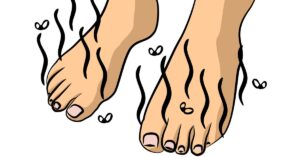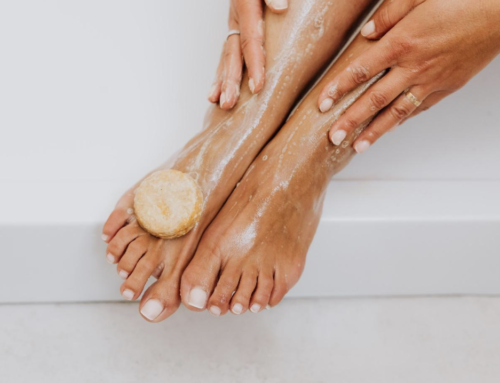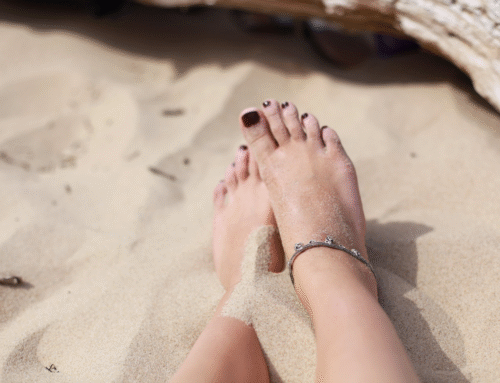Treatment for toenails that smell like cheese can vary. It all depends if you have an infection, like toenail fungus. A cheese like smell coming from your toenails can be a toenail fungus infection symptom. It is important to seek medical attention if experience any additional symptoms of a toenail fungus infection.
What causes toenails to smell like cheese?
Contrary to popular belief, it’s not actually the toenail fungus infection itself that produces that cheesy smell. The culprit is a type of bacteria called Brevibacterium.
This bacterium naturally lives on human skin, especially in warm, moist areas like between your toes. It’s completely normal and harmless in small amounts. But when feet are enclosed in tight shoes or sweaty socks for long periods of time, the bacteria multiply rapidly. This produces that distinct odor often compared to cheese.
What should you do first if you have smelly toenails?
The first thing to do when you have a smelly toenail problem is to identify the cause of the issue. If you can’t wait to get an appointment with a doctor, there are some signs you can look for. If the smell is coming directly from the toenails, this is one indication that the root cause is fungal. Fungal spores infect the nail bed, which is the area under the toenail. These fungal spores are associated with the bad smell that comes from toenail fungus.
It makes sense that the associated smell would come directly from the toenails as well. Fungal growth is not dependent on cleanliness and actually develops when a fungal spore from the outside environment attaches to the nail bed. While the initial attachment of the fungus to the nails can happen to anyone, certain behaviors and pre-existing conditions make the development of a more serious infection more probable. People who exercise a lot are especially prone to fungal infections since their feet tend to be sweaty and moist. Sweaty and moist environments are the perfect places for fungal spores to grow.

Toenail Fungus Symptoms
Toenail fungus, medically known as onychomycosis, often develops gradually and can be easy to overlook in its early stages. One of the first noticeable symptoms is a change in the nail’s appearance. Typically, it begins with a small white, yellow, or brown spot beneath the tip of the nail. As the infection progresses, the discoloration spreads. The nail may become thicker, dull, or brittle, losing its natural shine. The edges of the nail often become ragged or crumbly. In some cases, the nail may start to lift away from the nail bed—a condition known as onycholysis. Patients may also notice an unpleasant odor coming from the affected nail due to fungal buildup and debris trapped beneath it.
As the infection worsens, toenail fungus can cause discomfort or pain, especially when wearing tight shoes or walking. The nail may become distorted in shape, making it difficult to trim. In severe cases, it can even separate completely from the nail bed. The surrounding skin may appear inflamed, scaly, or itchy, particularly if the fungus spreads beyond the nail area. Multiple toenails can be affected at once, and because the condition is contagious, it can spread to other nails. It spreads through shared nail tools, shoes, or floors in communal areas like gyms or pools. Without treatment, the infection can persist for years, leading to ongoing discomfort and cosmetic concerns. Recognizing these symptoms early and seeking proper medical care can help prevent progression and improve treatment success.
Preventing Toenail Fungus
Even after successful treatment, prevention is key:
- Dry your feet thoroughly after bathing or swimming
- Wipe between your toes and allow the shoes to air out
- Wear flip-flops in public showers or pool areas
- Avoid sharing shoes, socks, or towels
- Choose breathable footwear
- Maintain proper nail hygiene and trim nails regularly
- Use post-treatment care as recommended by our foot doctors
By keeping your feet clean and dry and practicing these habits, you can reduce the risk of reinfection
Treatment with Laser Nail Therapy
The PinPointe FootLaser offers several appealing benefits for individuals struggling with toenail fungus, medically known as onychomycosis, particularly those seeking a noninvasive, drug-free treatment option. One of its primary advantages is that it targets the fungus directly beneath the nail without the need for oral medications, which can sometimes cause liver-related side effects or interact with other prescriptions.
The laser energy penetrates through the nail plate to heat and weaken the fungal cells. This allows the body’s natural processes to promote healthy nail growth. The procedure is quick—typically lasting around 30 minutes per session—and requires no anesthesia or downtime. This allows patients to resume normal activities immediately afterward. For many, this makes it a convenient and safe alternative to long courses of antifungal pills or topical creams that may take months to show visible results.

We offer free consultations
We offer free consultations to see if laser treatment is right for you. At our clinic, laser nail therapy with the PinPointe Footlaser is our specialty. We focus on this treatment because it offers a safe, effective, and medication-free solution for stubborn toenail fungus. We understand how frustrating it can be to deal with thick, discolored nails and how overwhelming it is to sort through different treatment options.
During this consultation, our foot doctors will evaluate your nails, discuss your health history, and determine whether laser treatment is the best choice. During your consultation, we will:
- Examine your nails to confirm the diagnosis and assess severity.
- Explain exactly how the PinPointe FootLaser works and what you can expect during and after treatment.
- Give you a realistic timeline for seeing clearer, healthier nails.
- Answer any questions you have about nail care and preventing reinfection.
Our goal is to help you confidently move forward with a treatment plan that finally addresses your toenail fungus safely and effectively, without the side effects or drug interactions of oral medications.




